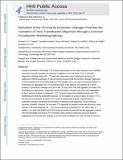| dc.contributor.author | Dasari, Anvesh K. R. | |
| dc.contributor.author | Arreola, Jenette | |
| dc.contributor.author | Michael, Brian | |
| dc.contributor.author | Griffin, Robert Guy | |
| dc.contributor.author | Kelly, Jeffery W. | |
| dc.contributor.author | Lim, Kwang Hun | |
| dc.date.accessioned | 2020-10-15T20:21:59Z | |
| dc.date.available | 2020-10-15T20:21:59Z | |
| dc.date.issued | 2020-06 | |
| dc.date.submitted | 2020-06 | |
| dc.identifier.issn | 1520-4995 | |
| dc.identifier.uri | https://hdl.handle.net/1721.1/128010 | |
| dc.description.abstract | Amyloid formation of full-length TTR involves dissociation of the native tetramers into misfolded monomers that self-assemble into amyloid. In addition to the full-length TTR, C-terminal fragments including residues 49-127 were also observed in vivo, implying the presence of additional misfolding pathways. It was previously proposed that a proteolytic cleavage might lead to the formation of the C-terminal fragment TTR amyloid. Here, we report mechanistic studies of misfolding and aggregation of a TTR variant (G53A) in the absence and presence of a serine protease. A proteolytic cleavage of G53A in the CD loop (K48 and T49) with agitation promoted TTR misfolding and aggregation, suggesting that the proteolytic cleavage may lead to the aggregation of the C-terminal fragment (residues 49-127). To gain more detailed insights into TTR misfolding promoted by proteolytic cleavage, we investigated structural changes in G53A TTR in the presence and absence of trypsin. Our combined biophysical analyses revealed that the proteolytic cleavage accelerated the formation of spherical small oligomers, which exhibited cytotoxic activities. However, the truncated TTR appeared to maintain native-like structures, rather than the C-terminal fragment (residues 49-127) being released and unfolded from the native state. In addition, our solid-state nuclear magnetic resonance and Fourier transform infrared structural studies showed that the two aggregates derived from the full-length and cleaved TTR exhibited nearly identical molecular structural features, suggesting that the proteolytic cleavage in the CD loop destabilizes the native tetrameric structure and accelerates oligomer formation through a common TTR misfolding and aggregation mechanism rather than through a distinct molecular mechanism. ©2020 American Chemical Society. | en_US |
| dc.description.sponsorship | National Institutes of Health (Grant NS097490) | en_US |
| dc.language.iso | en | |
| dc.publisher | American Chemical Society (ACS) | en_US |
| dc.relation.isversionof | https://dx.doi.org/10.1021/acs.biochem.0c00079 | en_US |
| dc.rights | Creative Commons Attribution-Noncommercial-Share Alike | en_US |
| dc.rights.uri | http://creativecommons.org/licenses/by-nc-sa/4.0/ | en_US |
| dc.source | PMC | en_US |
| dc.title | Disruption of the CD Loop by Enzymatic Cleavage Promotes the Formation of Toxic Transthyretin Oligomers through a Common Transthyretin Misfolding Pathway | en_US |
| dc.type | Article | en_US |
| dc.identifier.citation | Dasari, Anvesh K. R. et al., "Disruption of the CD Loop by Enzymatic Cleavage Promotes the Formation of Toxic Transthyretin Oligomers through a Common Transthyretin Misfolding Pathway." Biochemistry 59, 25 (June 2020): 2319–27 doi. 10.1021/acs.biochem.0c00079 ©2020 Authors | en_US |
| dc.contributor.department | Massachusetts Institute of Technology. Department of Chemistry | en_US |
| dc.contributor.department | Francis Bitter Magnet Laboratory (Massachusetts Institute of Technology) | en_US |
| dc.relation.journal | Biochemistry | en_US |
| dc.eprint.version | Author's final manuscript | en_US |
| dc.type.uri | http://purl.org/eprint/type/JournalArticle | en_US |
| eprint.status | http://purl.org/eprint/status/PeerReviewed | en_US |
| dc.date.updated | 2020-09-18T14:51:03Z | |
| dspace.date.submission | 2020-09-18T14:51:05Z | |
| mit.journal.volume | 59 | en_US |
| mit.journal.issue | 25 | en_US |
| mit.license | PUBLISHER_CC | |
| mit.metadata.status | Complete | |
